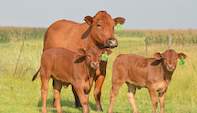
Farmers need to apply to join the Beefmaster SA Breeders Society, during which they also undertake to abide by the stipulations, order and regulations of the society’s constitution.
Along with this they have to pay Beefmaster SA and SA Studbook enrolments fees and are charged an additional amount based on the number of animals participating in the programme.
Membership is exclusive to farmers, who want to build or have a Beefmaster stud. The main difference between stud breeding and commercial production is that it is far more intensive, requiring much more time and attention to detail. Breeders, for example, have to keep records of each stud cow and stud bull, from the time they were born, as well as their offspring. Records include birth date and weight, weaning weight, weight at twelve and eighteen months, parentage and so forth.
All the animals are inspected once over the age of eighteen months. Bulls that make the grade are marked with the Beefmaster “Rocking B” brand and may be sold and used for breeding purposes. Bulls that do not make the grade have to be culled. Heifers that do not make the grade, may be sold or incorporated into commercial herds.
All the stud animals should be marked, either by tattoo, hot iron or freeze branding, with the stud mark as well as the year and identification number. An ear tag may also be used – these work best but can get lost, according to Beefmaster SA.
All Beefmaster stud animals should be registered with SA Studbook, who processes and safeguards the data on behalf of the breeders. Breeders should carefully check that animals are correctly marked and registered when buying or introducing new animals to the stud.
To join, farmers can either buy stud animals or take the long route by systematically upgrading their herd to stud status by using a Beefmaster stud bull on approved animals. Offspring needs to be inspected and approved each step of the way.
 Beefmaster cattle are a large breed of cattle known for its beef production in South Africa. According to Beefmaster SA, Tony Brink is seen ...
Beefmaster cattle are a large breed of cattle known for its beef production in South Africa. According to Beefmaster SA, Tony Brink is seen ...